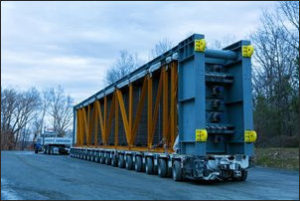
Bechtel, which helped build the Stonewall station, used a 500-tire trailer the length of a football field — to deliver manufactured components to the construction site.
Yesterday I wrote about the 778-megawatt gas-fired Panda Stonewall power station starting up near Leesburg. Against the backdrop of ongoing debate over gas versus solar here in Virginia, I wondered why the Dallas, Tex., investors behind the plant were willing to risk more than half a billion dollars in equity and debt on a merchant generating facility that would sell into the wholesale electricity market.
How did these newcomers to the Virginia energy scene see the future of electricity? Aren’t they worried that solar energy will displace gas in a few years as the price of solar continues to drop and the cost of natural gas is expected to rise? Aren’t they worried their big investment will be rendered valueless? Remember, Panda has zero political influence in Richmond, and the company can’t go running to the State Corporation Commission to bail it out if the bet on natural gas goes sour.
Bill Pentak, vice president of public affairs, says Panda Power Funds owns both gas and solar facilities. “We understand solar,” he says. “We built the largest solar project in the northeastern United States, covering 100 acres in southern New Jersey.”
Panda Power Funds will invest in projects that make economic sense, Pentak says, and right now the economics tend to favor natural gas. Take that New Jersey solar facility — it produces 20 megawatts of electricity. “That’s gross. But you’ve got to convert [the electricity] from DC power to AC. You lose 10 percent in the conversion. In the real world, it produces 18 megawatts.”
Then there’s the land use to consider, he says. Solar requires lots of acreage, and it takes up land that has alternative economic uses such as farming. The Stonewall plant takes up a fraction of the space and produces far more energy — 62 times as much on one fifth the land.
Then factor in solar’s intermittent production. Solar does not generate electricity at night, and it fluctuates during the day. The more solar installed, the more gas is needed as a backup. Says Pentak:
If you have ton of solar or wind on your grid, you make it less stable. If the wind dies down or the sun stops shining, the grid operator will have to call upon power that can be quickly dispatched. It won’t be coal fired, which takes three days to ramp up. It won’ t be nuclear, which takes three weeks. All that’s left is natural gas. A combined-cycle plant can cycle up in an hour and a half. A combustion turbine can in 30 to 40 minutes.
Thus, gas will be needed both as a base-load energy source and a back-up energy source. “We think Stonewall will operate as a base-load plant,” he says. But technology has blurred the distinction between peak load, intermediate load and base-load. Combined cycle plants — which generate electricity with gas-burning turbines and recycle the waste heat to run steam turbines — can operate as a base-load power source if need be, and also can dial output up and down as required.
Battery technology is not at the point where batteries can store enough energy to meet large-scale power needs, Pentak says. Moreover, batteries are not environmentally friendly. “Where do you put spent batteries? Solar technology is promising, but it’s not there yet.”


